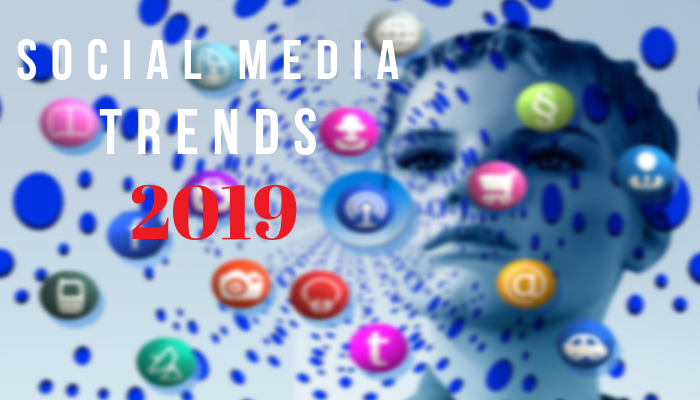
What does the word trend mean to you and your business?
Would you like to stay informed and ahead of the masses?
The word “trend” can evoke feelings of fear and uncertainty for businesses. You want to stay ahead of the curve, but you don’t want to waste time and money on something that isn’t going to stick around (or that isn’t relevant to your business).
To say 2018 was a tumultuous year for social media is an understatement. Simmering issues with privacy and data integrity came to a boil at Facebook, with effects felt at the highest levels of government. Networks in the crosshairs of congressional investigations have had to reckon with their own power and potential for abuse, while users have been left to question the larger impact of social media on politics, culture, and civic discourse.
What does this mean for 2019?
Where Social Networks Are Headed

THE RETURN OF REAL
Waves of scandal have had a tangible impact on faith in social networks. According to Edelman’s 2018 Trust Barometer Report, 60% of people no longer trust social media companies. Against a backdrop of “fake news” and data manipulation, users have grown distrustful of influencers–both celebrities and media personalities.
In a major reversal, trust has reverted back to immediate friends, family, and close acquaintances on social media, individuals whose personal credibility speaks far more than the size of their followings.
Organizations face 3 key challenges in 2019
- Data breaches make trust more important than ever
- The growing importance of personal branding to business branding
- The ad spend is increasing but you’ll need to consider ad saturation
RISE IN SOCIAL COMMERCE
The media went abuzz when Amazon hit a $1 trillion market cap. Interestingly, however, very little of this growth can be attributed to social media. And that’s significant because social media is a big deal, particularly in developing nations.
As research by PWC and GlobalWebIndex show, a trend where users are beginning to shop heavily through social media in the Asia Pacific is laying the groundwork for social commerce to gain traction in the west. In 2019 and beyond, we can expect to see a significant rise in social commerce both in the west and in developing nations.
TRENDS
1. REBUILDING TRUST
Brands get human as the circle of trust on social media tightens

2018 represented a crisis year for trust on social media.
In recent months, consumers, regulators, and media observers have questioned the privacy, accuracy, and ethics of nearly every social network.
The result: 60 percent of people no longer trust social media companies.
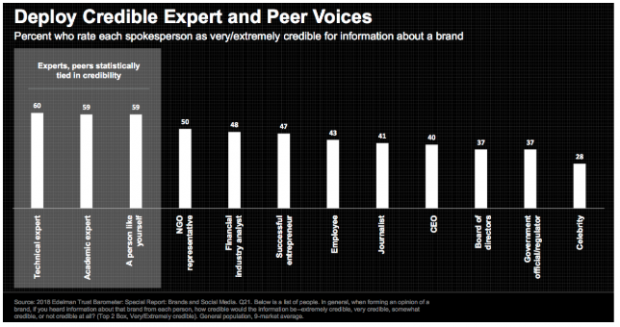
Source: Edelman 2018 Trust Barometer Special Report: Brands and Social Media
2. THE GROWING IMPORTANCE OF PERSONAL BRANDING TO BUSINESS BRANDING
Particularly for small businesses, putting a real, human face to a brand name helps to build loyalty. A brand that’s more relatable, and has the human element, naturally garners more trust, and trust is essential for building relationships.
One way to humanize a brand is to promote the personal brand of the business owner or a high-level leader. This tactic has become a staple for many organizations, as demonstrated through guest blogging, podcast and webinar appearances, and other publicity opportunities. By enabling your audiences to get to know the character and expertise of company leadership, a business can strengthen its brand reputation.
I expect that businesses which embrace this in 2019 will have a distinct advantage over companies that hide behind their logo.
3. THE RISE OF LINKEDIN
While scandal and controversy have rocked other networks, one channel has quietly trucked along in the background: LinkedIn. The buttoned-down business network passed the 500 million member threshold in 2018. A content powerhouse, LinkedIn now publishes more than 100,000 articles a week on its blogging platform.
Beefed-up groups functionality, native video, and a new API for integrations with third-party apps all show that these days the network is far from just a place to warehouse your resume. At a time when other feeds are increasingly filled with toxic rants and viral memes, LinkedIn’s no-nonsense professionalism has a stronger appeal than ever–as witnessed by the accelerating pace of user growth.
Companies who succeed in social media in 2019 will find creative ways to leverage LinkedIn’s unique place in the social universe–at the intersection of the “personal” and the “professional.” A natural choice for B2B marketing, LinkedIn is also, increasingly, a channel to reach affluent consumers. Of it’s half-billion members, 44% make more than $75,000, and more than half boast a college degree. Meanwhile, in a record-tight labor market where recruitment is an existential challenge for many businesses, the network also offers an ideal platform to showcase employer brand, i.e., a company’s culture and reputation as a place to work. Case in point: A LinkedIn blog post on how much we value our Hootsuite sales team and how hard it is to find great tech salespeople led to more than 1,000 visits to our career page and 100-plus applications.
4. LONG FORM CONTENT FOR MAKING AN SEO IMPACT
While word count is not the only thing that can impact how prominently an article will appear on search engine results pages, SEO experts agree that long-form content can give you an edge.
Although Google doesn’t penalize blog posts if they fail to reach a certain word count threshold, it stands to reason that a high-quality article with 1,600 words will likely outrank a high-quality article with 500 words. It’s for that reason that I believe we’re seeing more publishers requiring guest authors to submit articles with a minimum of 1,000 or more words.
I believe we’ll see more company blogs embracing long-form content, and incorporating it into their content strategies. Therefore, businesses that have found they aren’t getting SEO traction with short posts may want to “go long” and add more comprehensive articles, rich with information and insight, in order to both attract readers and give Google a reason to rank them more favorably.
5. VIDEOS, PODCASTS, & LIVE STREAMING
Blog posts can still be effective in 2019. Long-form posts can still engage readers, provided that they are appealing and properly formatted to facilitate the reading experiences across all devices.
Content consumption though goes way further than written text, with videos and podcasts seeing great success.
From the rise of YouTube to the introduction of IGTV, social media platforms were always interested in highlighting video content.
Facebook has even adjusted their algorithm to ensure that video posts show up more frequently on feeds.
Video marketing is becoming more appealing both for brands but also for users who notice the content that stands out.
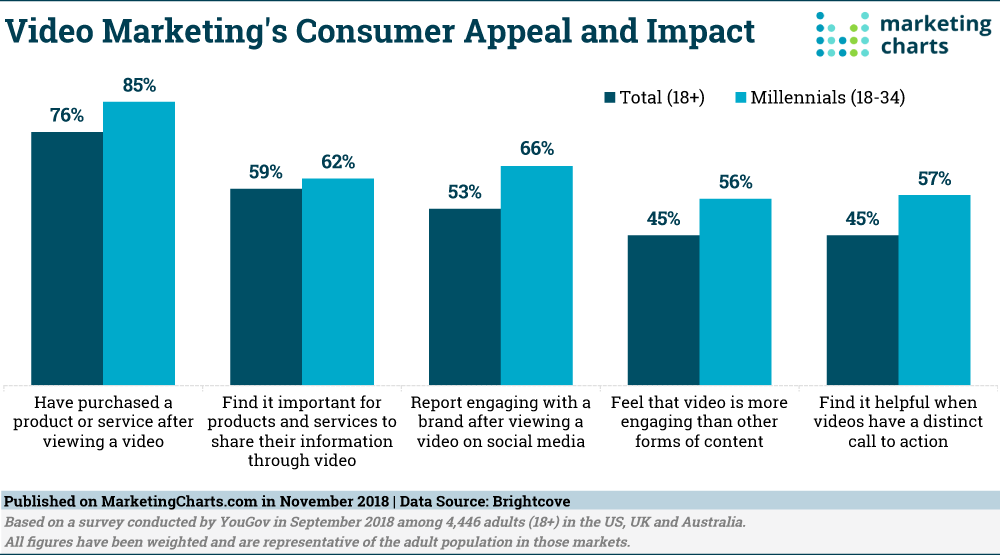
It’s only a matter of time until videos take over the whole social media world. 2019 will be the year that more brands will experiment with different types of video among different channels:
- Short videos with captions are really appealing to mobile users and are also accessible to everyone. They can be found on any social media platform with Facebook favoring them in their algorithm. They can make really effective ads and they’ve already been used quite extensively from ads.
- Vertical videos on Snapchat and Instagram Stories grow really fast in popularity and we already see many ads in a vertical format. It’s a format that will grow even more like a trend due to the improved viewing experience in mobile screens.
- Long videos of powerful storytelling can still keep an audience engaged. Whether it’s YouTube, Facebook, or even IGTV, there is an increasing need for video stories that can be interesting enough to convince the viewers to watch more than a few seconds.
- Live streaming is also another big trend that is now available across many different platforms. Users turn into broadcasters and brands become publishers to come closer to their audience. There are numerous opportunities to benefit from a live streaming strategy.
Except for videos, podcasts have also seen a growing success. Audio content is bringing the radio days back as a great way to catch up with your favorite stories and brands when you’re on the go.
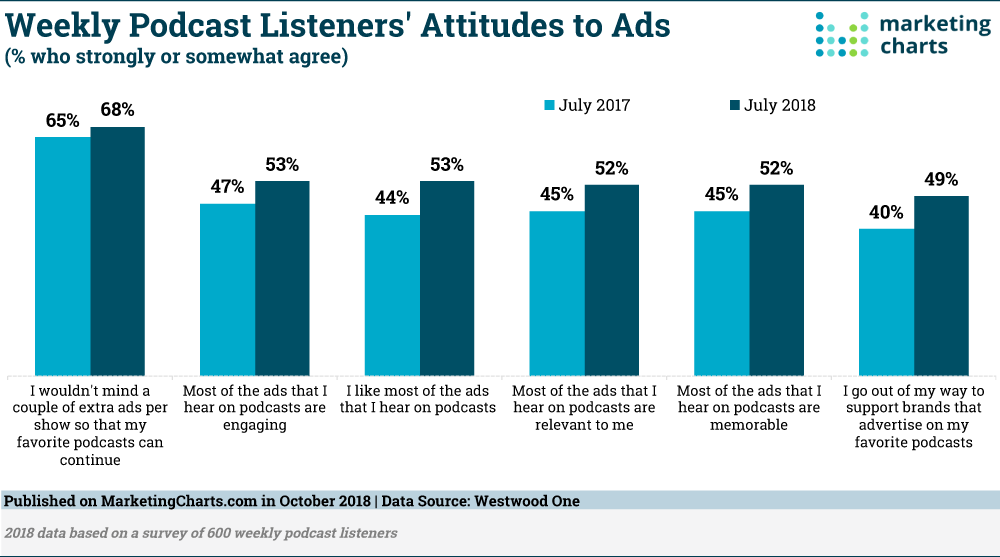
More marketers are experimenting with podcasts, either to build their own personal brand or to promote their business. What makes podcasts special is the fact that they still focus on the content rather than the promotion.
People subscribe to a podcast because they are interested in the content, whether it comes from a brand or another person.
6. MESSAGING TAKES OVER THE WORLD
Customers demand better 1:1 social experiences
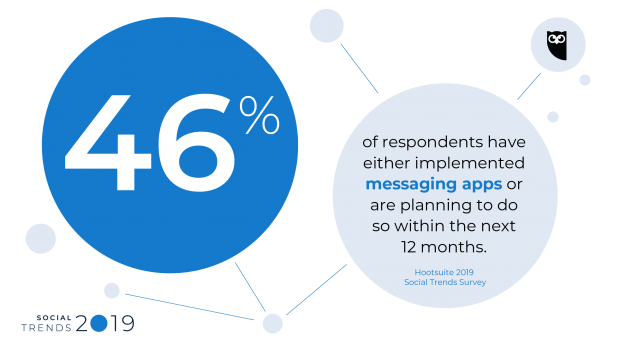
The top messaging apps—WhatsApp, Facebook Messenger, WeChat, QQ, and Skype—combine for nearly 5 billion monthly active users. That’s more users than the traditional social networks have worldwide.

Across the board, users are spending more time on messaging and less time sharing news on social. This shift from public to private spaces is changing consumer expectations.
Nine out of 10 consumers would like to use messaging to communicate with businesses, according to a survey of 6,000 people globally. In the U.S., messaging is the most preferred customer service channel. In a 2018 survey of 8,000 people conducted by Facebook, 69 percent of respondents said that directly messaging with a company helps them feel more confident about the brand.
What’s clear, however, is that consumers don’t want more advertising channels. Smart brands are using messaging apps for more high-value conversations.
So, how do you up your messaging game?
- Enable Facebook Messenger for your Facebook Business Page.
This guide shows you how to enable Facebook Messenger on your business Page.
Once you’ve done that, set up an instant reply for when users send you a message. This can be as simple as a short greeting, or you can provide more information such as typical response times and support hours. You can also share links in your instant replies to direct people to support pages or frequently asked questions.
- Add plugins to your website that drive customers to messaging apps.
Show that your brand is available on messaging apps by adding plugins to your website. That way, customers can easily click on the plugin and reach you if they’re already on your website looking for information.
- Use DMs and/or messaging apps to streamline customer service queries on social.
When customers reach out to your brand on social, it’s important to move the conversation from a public to private space. That way, you can ask for personal information like phone numbers and address details to resolve the problem faster. This can also preempt the need for time-consuming follow-up phone calls and emails.
If your team isn’t available at all times of day, post your support hours and time zone in your bio so customers know when they’ll get a response.
ADVANCED
- Set up bots and/or in-app assistants for frequently asked questions.
Bots are an important way to scale your customer service efforts and create better experiences on social. While they can’t replace an in-person experience, they’re extremely effective for answering simple questions and helping with more transactional exchanges. This frees up time for you to focus on more complex customer needs.
To get started building your own bot, check out tools like ManyChat, Chatfuel, or Conversable. (Just be sure to keep in mind the dos and don’ts of messaging bots.)
- Run campaigns that incorporate messaging apps.
Get creative with your social media campaigns and think beyond the news feed. Contests are a good way to start connecting with your customers because they often include a private messaging element to share contest results. Messaging campaigns often work best on mobile formats, so keep that in mind when creating your campaign.
For example, Coca Cola ran a summer contest using Messenger and chatbots. Aimed at a younger demographic, the entirely mobile campaign encouraged customers to take pictures of their Coke bottles through Messenger to automatically enter to win prizes.
Protip: Always check the latest promotion guidelines for each network before planning your strategy.
- Experiment with Facebook Messenger ads.
If your target audience uses Facebook Messenger, it’s worth putting some budget into Messenger ads. With features like automatic placement, Facebook will deliver ads automatically to your followers. (However, if you choose to edit placements, you can only run Messenger ads in coordination with News Feed ads—they’re not available as standalone placements yet.)
Be mindful of when and how you use these ads, as contacting a potential customer by private message is a lot more personal and intimate than publishing a banner or News Feed ad. Make sure your ads are useful, immediate, and actionable. For example, you can share a discount or coupon after someone has made a purchase.
7. ClOSING THE ADS GAP
More competition on paid social forces marketers to up their game
SOCIAL ADS OVERLOAD
The ad spend is increasing but you’ll need to consider ad saturation
Social media advertising has been on the rise the last few years. We are now able to create social ads in multiple channels and it’s up to us to decide on the objectives and the type of ads that we want to use.
There has been an increasing success for many brands that used paid social in the marketing mix. It’s no surprise that there is a growing ad spend across marketers.
For example, Instagram’s level of engagement has intrigued more marketers to increase their ad spend to the channel, both on the feed and the Stories.
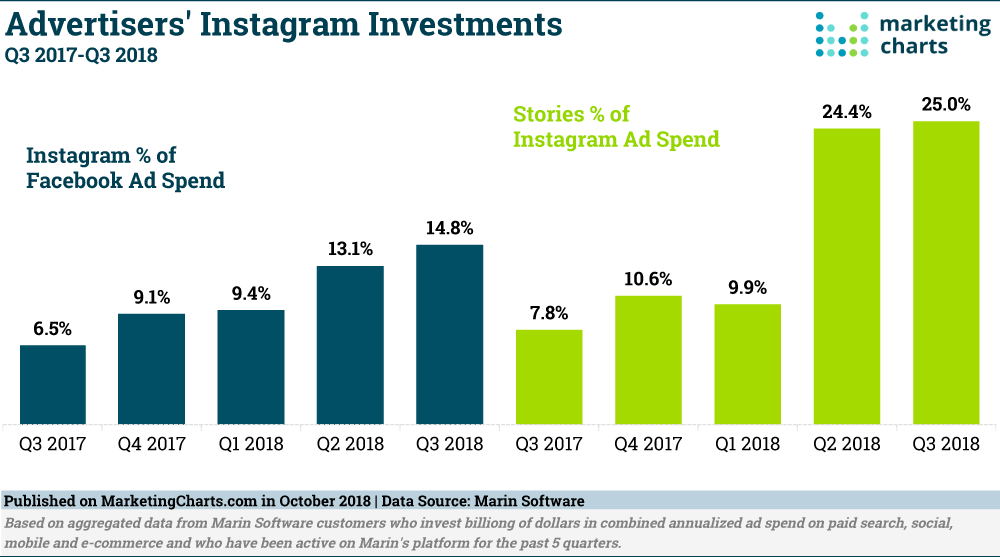
By now, everyone knows we’re in the pay-to-play era on social.
Accordingly, marketers are increasing social ad budgets (up 32 percent in 2018 alone) and producing more ads than ever before. One of every four Facebook Pages now use paid media. And Facebook already accounts for 23 percent of total U.S. digital ad spending.
But rising costs and fleeting attention are limiting ROI for advertisers.
To counter this, paid social teams are pairing ad money with equal time investment, creativity, and targeting savvy. And they’re paying to boost their best performing organic content.
Spotify and Netflix are leading the way with creative social ads that are at once personalized and entertaining, rather than just bland banner ads squeezed into a news feed. The end goal is to generate user discussion and engagement, rather than simply “broadcast” an ad at an audience.
We’re seeing brands build out their social teams (both in-house and agency) with skilled cross-platform content creators versed in video, motion graphics, design, and more. Enhanced third-party ad targeting tools, which enable easy A/B testing (in some cases with hundreds of variants), are also becoming the norm.

- Understand and target the right audience.
Knowing your audience is key to high engagement. Each ad campaign should target a focused group based on interests, jobs, relevant competitors, and previous interaction with your brand.
Social networks have different targeting options depending on the type of ad you want to create. If you don’t know who you’re supposed to target and why, research your customers to understand what their challenges are. Also find out how they interact with your business, brand, products, and services.
- Define your goals and metrics.
It’s important to show that social media has a positive bottom-line impact on your business. That’s why every ad campaign should have goals and metrics that tie back to business objectives and that you know how to measure.
Your metrics will depend on the type of campaign you’re running and the audience you’re targeting. Awareness campaigns, for example, might focus on impressions, while conversion campaigns should put more value on click-throughs.
- Invest in high-quality content.
With more brands competing for people’s attention on social media, ordinary posts aren’t good enough anymore. You need to create high-quality content that will resonate with your audience.
Create compelling visuals, which are essential for clicks and high conversion rates on social media. Not every brand will have the budget for expensive equipment or a professional crew. But, learning some video basics or even hiring a freelancer can make a big difference.
ADVANCED
- Repurpose concepts from top-performing organic content.
Creating high quality social ads takes time and money. Test your ad concepts as organic posts first to see how they perform. Once you see what’s working, you can adapt and repurpose your top performing organic content for ads.
This strategy will improve ROI because you’re investing resources into something that has already been tested.
- Use what you’ve learned from previous campaigns to improve performance.
By running ads and measuring their performance, you can compare results and set benchmarks for future campaigns.
The right analytics tools can help you track results and revenue generated by your social media efforts. Incorporate these insights into your future efforts.
- Embrace new ad formats.
The social ad space is one of constant innovation. Newer formats have the advantage of tapping into consumer curiosity, while also avoiding ad fatigue.
Instagram Stories ads, for example, have been around since 2017. But this year Instagram gave brands the ability to use three consecutive photos or videos. Pinterest recently rolled out wide-format promoted videos. And Facebook Messenger ads now allow brands to connect with customers directly via instant messaging.
- Split-test for success.
No matter how savvy your ad team is, it’s impossible to predict what users will actually click on. That’s where split-testing (also known as A/B testing) comes into play.
This scientific approach involves running multiple ads with slight variations (different images, different headlines, and so on) and then doubling down on the top performers.
Facebook offers basic split-testing functionality through its dynamic creative ads, but for streamlined testing with lots of options, consider a third-party ad tool.
FINAL THOUGHTS
Change: An Ever-Constant Trend
The one trend you can always count on resurfacing year after year is that businesses must, to some degree, adjust their social media approach to gain broader awareness, and increase engagement with customers.
Mark Zuckerberg once said, “Figuring out what the next big trend is tells us what we should focus on.” And while that might be true for Facebook, you should also realize that it isn’t always so for every business.
The thing about trends is that following them doesn’t guarantee success – I advocate for paying attention to social media trends, but before you jump on the bandwagon, carefully evaluate before incorporating them into your marketing strategy, and ensure that you always remain consistent with your brand and business efforts.
Social media marketing is going towards a stage that focuses more on ROI, new technologies and a trusting relationship between the brand and the customers.
The only way to survive in-between data breaches, emerging technologies and new platforms is to ensure that you:
- Understand your audience
- Review your social media marketing strategy
- Allocate time and budget to new tools and technologies
- Keep your focus on what works
- Do your best to build trust with your users in every campaign
Source: Hootsuite
About Blair

Blair Evan Ball is a Social Media Coach and founder of Prepare1, a company that works with businesses, individuals and non-profits. He is a former executive with a Fortune 50 company, and his national division did $1Billion+ in sales annually.
Blair has written three e-books: Facebook for Business Made Easy, Facebook Pages for Business Made Easy, and WordPress Blog Setup Made Easy.
Blair also educates, trains entrepreneurs and business professionals how to amplify their brand, increase revenues, and raise more funds.
![[Study] How Will Businesses Change Their Social Media Activities 5 Golden Rules for Sharing on Social Media](http://www.prepare1.com/wp-content/uploads/2014/03/COACH-logohat-162x300.jpg) The Race is ON! | PREPARE | Get into the Game and WIN!
The Race is ON! | PREPARE | Get into the Game and WIN!



















